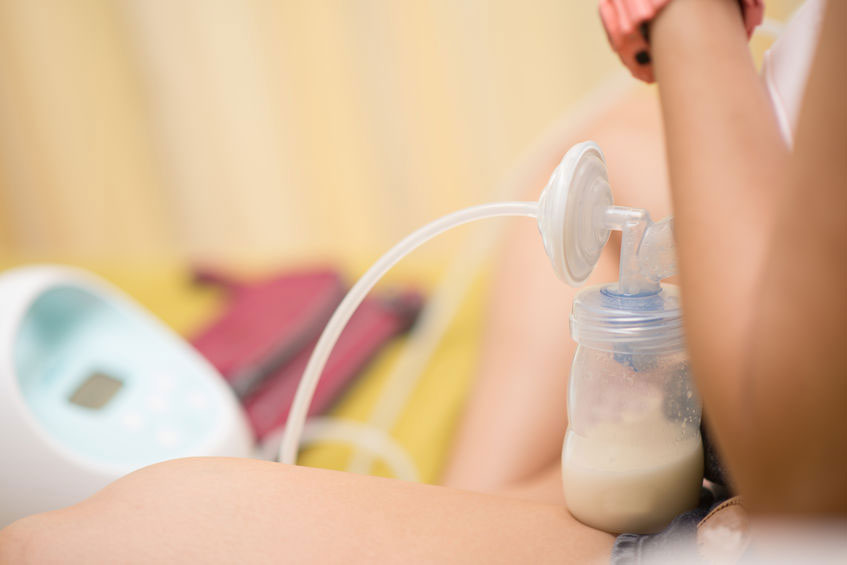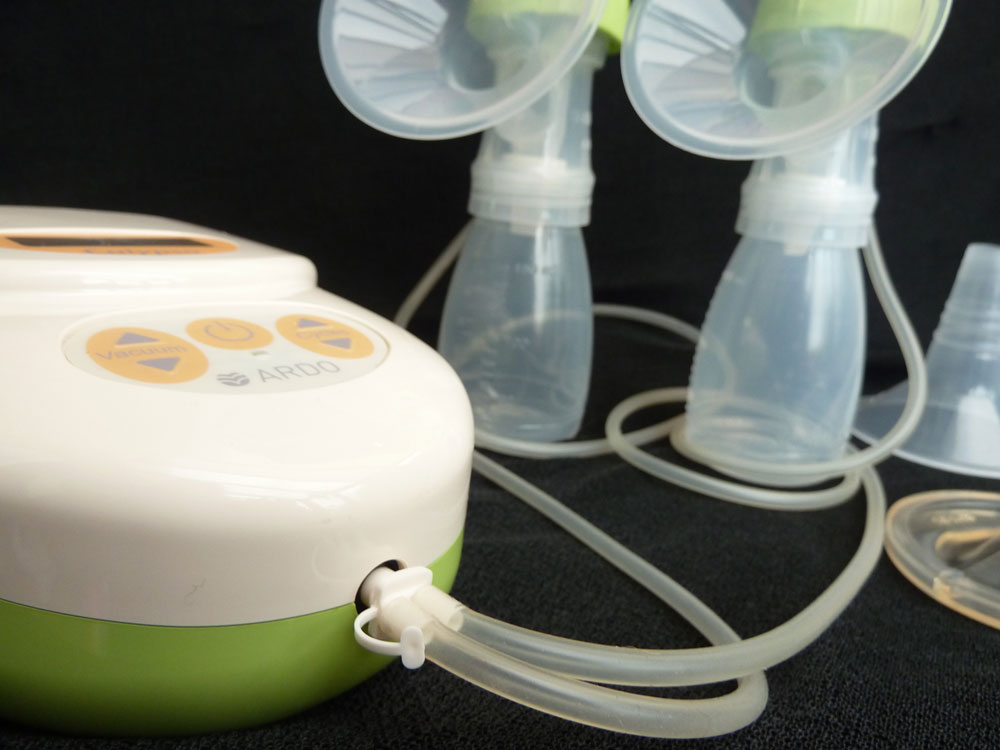A baby born before 37 weeks of completed gestation is called premature or preterm. Premature babies (also called prems or preemies) may need to spend time in a special care baby unit (SCBU) or neonatal intensive care unit (NICU) for help with breathing, temperature regulation, fluid loss, feeding or other medical issues. Many of the reflexes needed for breastfeeding such as extending the tongue to grasp the breast, the rooting reflex, or being able to coordinate sucking, swallowing and breathing may not be fully developed. All these difficulties can make breastfeeding a premature baby challenging, but breast milk is extremely important for these tiny babies and breastfeeding is possible from as early as 28 weeks gestation.
This article
This article discusses breastfeeding a premature baby including the importance of breast milk and skin-to-skin contact, how premature babies grow, and how to establish a milk supply. It is a companion article to Kangaroo Care for Your Premature Baby and Exclusively Pumping Breast Milk.

The importance of breast milk for a premature baby
Breast milk is important for all babies but even more so for premature babies who are so underdeveloped. Breast milk takes over the work of the placenta to continue a baby’s development. Breast milk provides:
- Active enzymes to help baby digest the milk and help their intestines mature, growth factors, and hormones1
- Antibodies and immune factors2 to protect from sickness, infections and childhood disease.
- Anti-inflammatory factors and anti-oxidants to help protect against the risk of necrotising enterocolitis (NEC); a life threatening bowel condition in premature babies (WHO/UNICEF, 2020)
- Protection from complications of prematurity such as feeding intolerance, late-onset sepsis, or retinopathy of prematurity (eye disorder) (WHO/UNICEF, 2020)
- Improved neurodevelopment outcomes (development of the brain and nervous system)) (WHO/UNICEF, 2020)

Targeted support
Studies suggest that breast milk produced at the particular time your baby is born is adapted for that stage of your baby’s development (gestation specific).34 The protective enzymes, hormones, immune factors, anti-inflammatory, anti-oxidant, and growth factors of breast milk appear to be concentrated in pre-term milk (WHO/UNICEF, 2020). Compared to “full-term” breast milk, one study found premature baby milk had higher concentrations of protein, sodium, chloride, iron and magnesium in the first four weeks after birth.5 The protein in breast milk is easier to digest and babies energy expenditure is lower with breast milk compared to those fed industrial formulas.6
Mouth care
Even gently swabbing a baby’s mouth (mouth care) with his mother’s colostrum can have a number of health benefits.7891011
Formula […] only has about 30 nutrients; your breast milk will give her the 1200 nutrients that a human baby needs for her brain to grow properly.

Preterm formula preparations
Although necessary sometimes, industrial formula can increase the risk of necrotising enterocolitis, allergies, asthma, sudden infant death syndrome (SIDS), meningitis, heart disease in later life, and reduces survival rates.12 Even enriched artificial milk developed specifically for the preterm baby (preterm formula) is inferior to breast milk and has poorer survival outcomes.13 For more reading see Supplementing With Formula and Human Milk Fortifiers.
First Steps Nutrition Trust summarises the benefits of breast milk compared to preterm formula:
A study of very low birthweight infants (23-34 weeks and between 490g-1700g) showed that implementing an exclusive human milk diet led to a significant decrease in the incidence of NEC, decreased feeding tolerance, decreased time to full feeds, shorter lengths of hospital stay and considerable cost savings (Assad, Elliott and Abraham, 2016). Evidence also suggests that human milk feeding in premature infants can play a protective role in preventing retinopathy, particularly severe retinopathy (Zhou et al, 2015). Preterm babies show improved cognitive development, speech and jaw development, visual acuity and earlier discharge from hospital compared with babies fed preterm infant formula (Altman et al, 2009; Horta et al, 2007; Huston et al, 2014; Rønnestad et al, 2005).
Human milk fortifiers
Opinions seem to vary on whether breast milk needs fortifying with certain nutrients for the very smallest premature babies. One study found breast milk was enough for very low birthweight babies in the weight group 1251-1500g.14 When needed, vitamin and mineral supplements (such as vitamin D, calcium, phosphorus and iron) can be provided either as individual nutrients, or via commercially-produced multi-nutrient fortifiers to be mixed with human milk. Multi-nutrient fortifiers are usually cows’ milk based, known as “human milk fortifiers”. See Human Milk Fortifiers for a discussion of the risks and benefits and the current recommendations from the World Health Organisation.
Feeding reflexes in the premature baby
By 28 weeks gestation a baby will have a strong rooting reflex and be briefly able to latch on (attach) to the breast for a few sucks although this may not be very coordinated. By 31 weeks, a baby can manage repeated swallowing of milk from the breast. By 30-32 weeks, babies can coordinate the suck, swallow and breathe needed for breastfeeding and by 34 weeks a baby can fully breastfeed.1516 17 By looking after your baby in kangaroo care (holding and carrying your baby against your chest ideally in skin-to-skin contact) he may learn to breastfeed sooner than these guidelines.
Even a 28 week prem can breathe properly on her mother’s chest, can breastfeed properly, and all her body systems can adapt to her new life.
Feeding options before breastfeeding is established
Alternatives to breastfeeding for the very premature baby are usually a progression from total parenteral nutrition (specific nutrients given by intravenous feeding, ie direct in a vein) to tube feeding by naso- or oro-gastric tube (NGT or OGT) to finger-feeding to cup feeding and finally to full breastfeeding (Bergman, 2010 p64). Bottles are not usually preferred as an alternative feeding method (see below). As small premature babies lose fluids quickly, they may need intravenous fluids until their mother’s milk comes in and baby may still need expressed breast milk by cup, NGT or supplemental feeding tube alongside breastfeeding for a while. During tube-feeding a baby can practise sucking the breast or mother’s finger. Each baby will need to be assessed individually to find the best combination of feeding methods for their needs until they are able to breastfeed effectively.
For more information see:
Breastfeeding is less stressful than bottle feeding
Some hospital staff think breastfeeding is tiring or stressful for a preemie, however some studies have found that breastfeeding is less stressful than bottle feeding.1819 Cup feeding has also found to be less stressful than a bottle feed.20 Berger et al found no difference in preterm babies’ resting energy expenditure when they were breastfeeding compared with bottle feeding.21 Another study indicated babies’ energy expenditure appeared to be less when they were breast milk fed compared with formula fed.22
Falling asleep at the breast?
Falling asleep at the breast doesn’t prove that breastfeeding is tiring. Babies fall asleep contentedly at the breast after a good feed all the time. However, a baby who falls asleep at the breast before he has had enough breast milk may do so because they are not getting a good flow of milk (low milk supply/poor latch) and/or because they don’t have much stamina. This can be common in premature babies or underweight babies. Improving the flow rate by improving the latch, using gentle breast compressions or using a supplemental nursing system may help to keep baby awake for longer. However, supplementary bottle feeds alongside breastfeeding may sometimes be the best option for a particular baby. An IBCLC lactation consultant can help you with your milk supply (see below) and general breastfeeding management.
Nipple shields, pacifiers and teats
- Nipple shields. Some premature babies may find feeding easier with a nipple shield and in some cases may get more milk by using them for a while.23 However one review found some studies indicated nipple shields, supplemental nursing systems and use of syringe feeding had a detrimental effect on a mother’s confidence (self-efficacy) and subsequent length of breastfeeding.24
- Pacifiers. Generally pacifiers can interfere with breastfeeding by affecting latch and suck, affecting future teeth alignment, and are linked with causing ear infections. However for the premature baby they may be helpful if they prevent a premature baby from crying and the associated stress and damage that can result from crying. Sucking a pacifier during tube feeding may also stimulate the vagus nerve to facilitate digestion (if the breast is not available).25 For the baby in skin-to-skin contact with a parent or care-giver, pacifiers are not generally needed.
- Bottle teats. Bottles can be more stressful for a premature baby than cup feeding or breastfeeding (see #2 above). If bottles are required see Best Bottle for a Breastfed Baby and Tips to Bottle Feed a Breastfed Baby.

Skin-to-skin and kangaroo care for a premature baby
Holding and nurturing your baby in skin-to-skin contact (without clothes between you, or very few) has many health benefits for all babies and is especially important for premature babies.26 In skin-to-skin contact the mother’s body regulates (stabilises) a baby’s body systems such as heart rate or temperature, optimises brain growth and feeding reflexes, and provides the baby with an emotional connection. When a baby is continually held in kangaroo mother care, the benefits are even greater; the baby has increased resilience and better health. Separation between mother and baby is stressful and without the mother’s stabilising effect, the infant is more vulnerable. Stress affects the baby’s heart rate and growth while the hormone cortisol (a chemical messenger produced in the body following stress) can disrupt a baby’s brain with long lasting effects.2728
Skin-to-skin contact

Holding your baby in skin-to-skin contact as much as possible will help your baby’s body systems such as heart rate, oxygen levels or temperature to stabilise more quickly and also stimulate your baby’s feeding reflexes. Skin-to-skin contact is still possible while a baby receives medical support such as CPAP (continuous positive airways pressure), ventilation 2930, treatment for jaundice or has intravenous fluids 31 Your health professionals will help you position your baby on your chest so that his tiny neck and airway are supported in the “sniffing position” to help him breathe. See Why Skin-to-Skin? for more reasons why this is such a helpful and beneficial practice.
Kangaroo mother care
Kangaroo mother care (KMC) alongside any medical help that is needed, is well recognised as the best care for a preterm baby. KMC is an extension of holding your baby in skin-to-skin contact but when the baby spends most of the day and night on their mother’s body or a substitute body (father, grandparent or other care-giver) in continuous care. A recent important study showed that when kangaroo care is used from birth there are higher survival outcomes than waiting for a baby to stabilise in an incubator before KMC is initiated.32 Kangaroo care has all the physiological benefits of skin-to-skin contact, prepares your baby for breastfeeding sooner, helps weight gain333435 and promotes healthy brain development. One study found long-lasting social and behavioral protective effects 20 years later.36 See Kangaroo Care for Your Premature Baby for further information.
Extensive research supports the benefits of skin-to- skin care for both the mother and infant. For the infant, skin-to-skin care reduces infant mortality and morbidity, as well as increasing exclusive breastfeeding, decreasing neonatal ward stay and hospital readmissions, and improving short and long-term outcome. Skin-to-skin care decreases pain response in preterm infants during the many painful procedures experienced during the hospital stay. There is also some evidence of improved sleep patterns and improved brain maturation. For the mother, skin-to-skin care improves milk volume, assists with bonding and attachment, boosts parental engagement and improves breastfeeding. Fathers benefit as well.
Kangaroo father care
Fathers can help with skin-to-skin contact particularly if mother is unavailable for a while such as after a surgical birth and this can calm their infants and regulate their temperature.3738 Dr Bergman explains:
skin-to-skin contact should start at birth, and given the low or zero separation tolerance of these smallest babies, the SSC should also be continuous. To achieve this, mother and father need to take turns and both be equally involved in providing SSC, over and above which mother needs to provide expressed breast milk, well before baby is able to suckle on its own.
Father’s experiencing SSC [skin-to-skin contact] in this way seem profoundly moved and develop a special bond with these babies.
Establishing your milk supply
Breast milk is created on a supply and demand basis. the more milk that is removed from the breasts the more will be created to replace it. A high demand in the early weeks sets the scene for a good robust supply later. In order to build a full breast milk supply it is essential to keep removing milk from the breasts every few hours just as your baby would do if they could breastfeed competently. Milk can be removed by a combination of hand expressing or using a good breast pump, see Hand Expressing Breast Milk, Exclusively Pumping Breast Milk and How Long Does Breast Milk Last? Good practice includes;
- Hand express in the first hour after birth to mimic a newborn’s first breastfeed and then hand express or pump at least every two hours during the day and once at night is a good goal. Aiming to express 750–1000ml (25–34oz) by 7–10 days after birth will help protect milk supply for the following weeks.39 If breastfeeding twins a mother will be aiming for double these volumes. Breastfeeding Your Premature Baby by Jane Morton explains why it is important to maximise milk production as soon as possible.
- Early skin-to-skin contact between mother and baby and kangaroo baby care.
- Discuss galactagogues (foods, herbs and prescription medication that can help milk supply) with your doctors.
- Encourage baby to suckle on an empty breast if they are not mature enough to breastfeed yet.40 Practicing breastfeeding is important, even if initially your baby sucks without taking any milk. Until your baby can coordinate sucking, swallowing and breathing at the same time, they can practice sucking skills on a pre-pumped (empty) breast.
- Expect frequent feeds, premature babies have tiny tummies and breast milk is quickly digested. In your uterus your baby would have been fed constantly via the placenta. Premature babies have very tiny stomachs and if a feed is too big it leaves them prone to reflux, higher risk of aspiration in their lungs, pneumonia, bradycardia (slow heart rate), apnoea (pauses in breathing), colic, and NEC (Bergman, 2010). Small feeds more frequently are likely to be preferable and more stabilising.41 In Hold Your Prem the authors suggest feeding preemies small volumes every 60-90 minutes.
- Keep expressing to keep up your milk production until your baby can breastfeed effectively without needing reminders or topping up.
- Contact an IBCLC lactation consultant to help you find good positions for your tiny baby to breastfeed and support you to build a good supply of breast milk.
Useful links for further reading on this website include:
- Is My Baby Getting Enough Milk?
- A Good Start to Breastfeeding
- Latching Tips
- How Often Should a Newborn Feed?
- Breastfeeding a Sleepy Baby
Reasons for low milk supply
In addition to the potential reasons for No Breast Milk After Delivery or Reasons for Low Milk Supply the mother of a premature baby can have additional risks for low milk supply due to:
- Routine administration of corticosteroids during uncomplicated premature labour may cause lower milk supply 42
- The effect of a stressful birth/worries about the baby increasing stress hormones
- Breast development may have not completed due to a shorter gestation or if the placenta was not functioning optimally.
An IBCLC lactation consultant can be an excellent partner to help you maximise the milk you can produce and see How to Make More Breast Milk and How to Increase Milk Supply While Pumping.

How premature babies grow
Preterm babies are said to have a slower weight gain than babies born at term. The UK has separate growth charts available for babies born at 32 to 36 weeks’ gestation for boys and girls and a low birthweight chart for preterm baby boys and girls born before 32 weeks’ gestation.43
Growth rate
Expected growth rates cited in Kangaroo Mother Care, A Practical Guide, World Health Organisation, 2003 are:
- 20g/day up to 32 weeks of post-menstrual age, corresponding approximately to 150-200g/week;
- 25g/day from 33 to 36 weeks of post-menstrual age, corresponding approximately to 200-250g/week;
- 30g/day from 37 to 40 weeks of post-menstrual age, corresponding approximately to 250-300g/week.
Gestational correction for preterm babies
Gestational correction is a way to adjust for gestational age if a baby is born before 37 weeks and is used until the baby is one year old or until two years of age if they were born before 32 weeks gestation.44 For more information about plotting preterm birth charts see UK-WHO Growth Charts – Fact Sheet 5 Plotting Preterm Infants.
Helping a premature baby to gain weight
Improvements in a premature baby’s weight have been noted with:
Kangaroo care and skin-to-skin
All babies benefit from being held skin-to-skin. But for premature babies this appears to be even more important for their growth rate and weight gain as well as healthy brain development. Authors and medics Jill and Nils Bergman have noted preterm babies who can grow at the same rate as a term baby when carried skin-to-skin in kangaroo care. See their book Hold Your Prem for more information.
Raising fat levels in breast milk

If a baby isn’t gaining weight well on his mother’s milk, despite a mother having plenty of milk, it is possible to adjust the fat levels in breast milk and so raise the calorific value by knowing:
- Combining hand expressing with pumping can increase the calorie content in milk45
- The fat content of milk increases towards the end of a feed. If you’re pumping, milk expressed towards the end of a pumping session will have a higher fat content. If baby is feeding directly at the breast, gentle breast compressions or breast massage can help release higher fat milk.
- Breast milk tends to have higher calorie content in an evening 46
- Breast milk can be centrifuged to obtain the higher fat cream layer at the top of the milk which can be used to increase the calorie concentration of breast milk. This can be done in a milk bank.47
Fortifying human milk?
As discussed above, industry made cows’ milk based fortifiers are sometimes added to breast milk to promote faster weight gain in premature babies. Studies indicate fortifiers can create short term weight gain but there can be health concerns associated. For a full discussion see Human Milk Fortifiers.
Using donor breast milk
If you do not have enough breast milk see below for ideas to increase your supply. In the mean time, if available, pasteurised donor breast milk from a milk bank is much better for your baby than preterm formula until you can build your milk supply.

Summary
Breast milk is very important to a premature baby who may have complex medical needs. Skin-to-skin care can help with brain development, stability, weight gain and facilitate breastfeeding. Premature babies can begin to breastfeed at around 28 weeks gestation. There is a mix of opinions on the safety of bovine based breast milk fortifiers and whether the faster weight gain they claim to encourage is beneficial or outweighs the potential harm of introducing cows’ milk products. It is important to get good help to get your milk supply established and optimised.